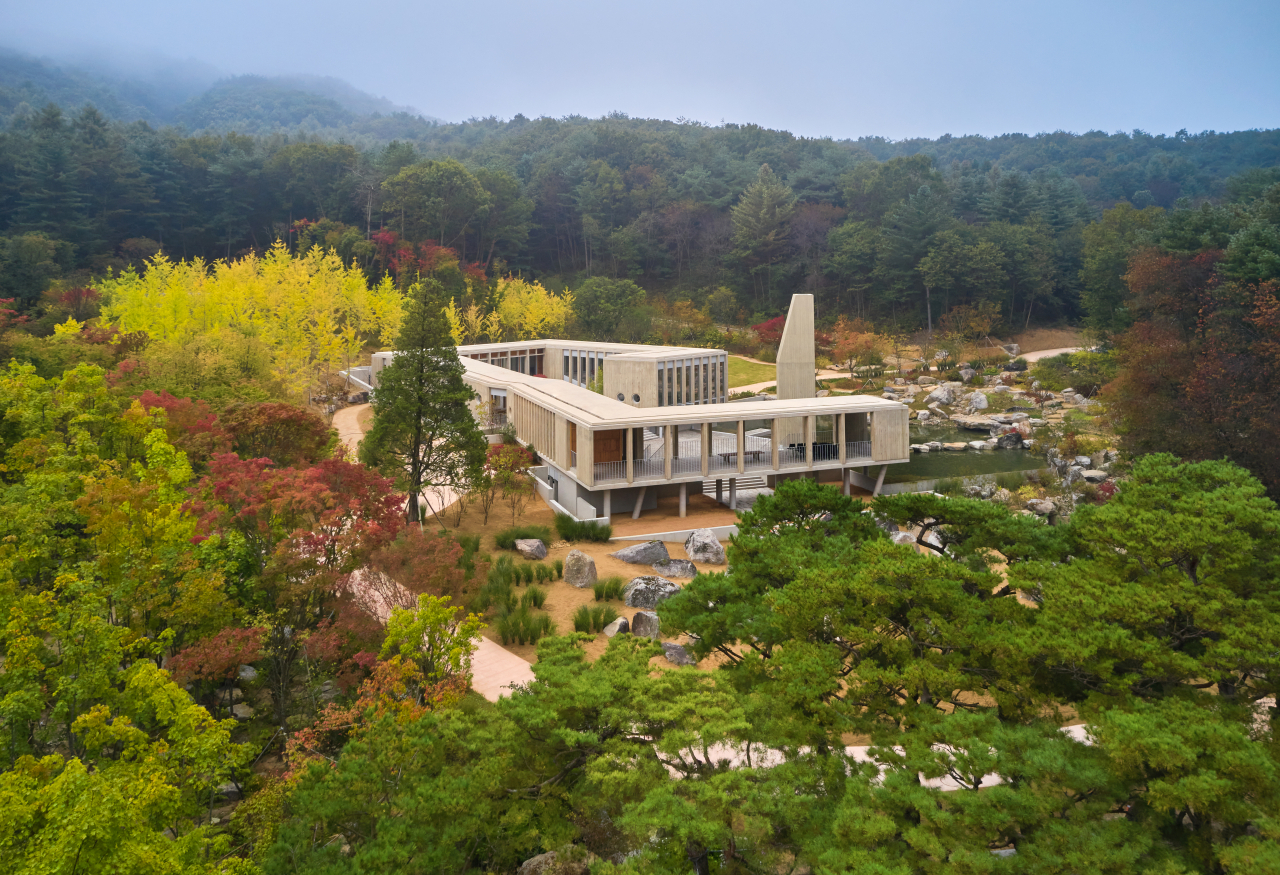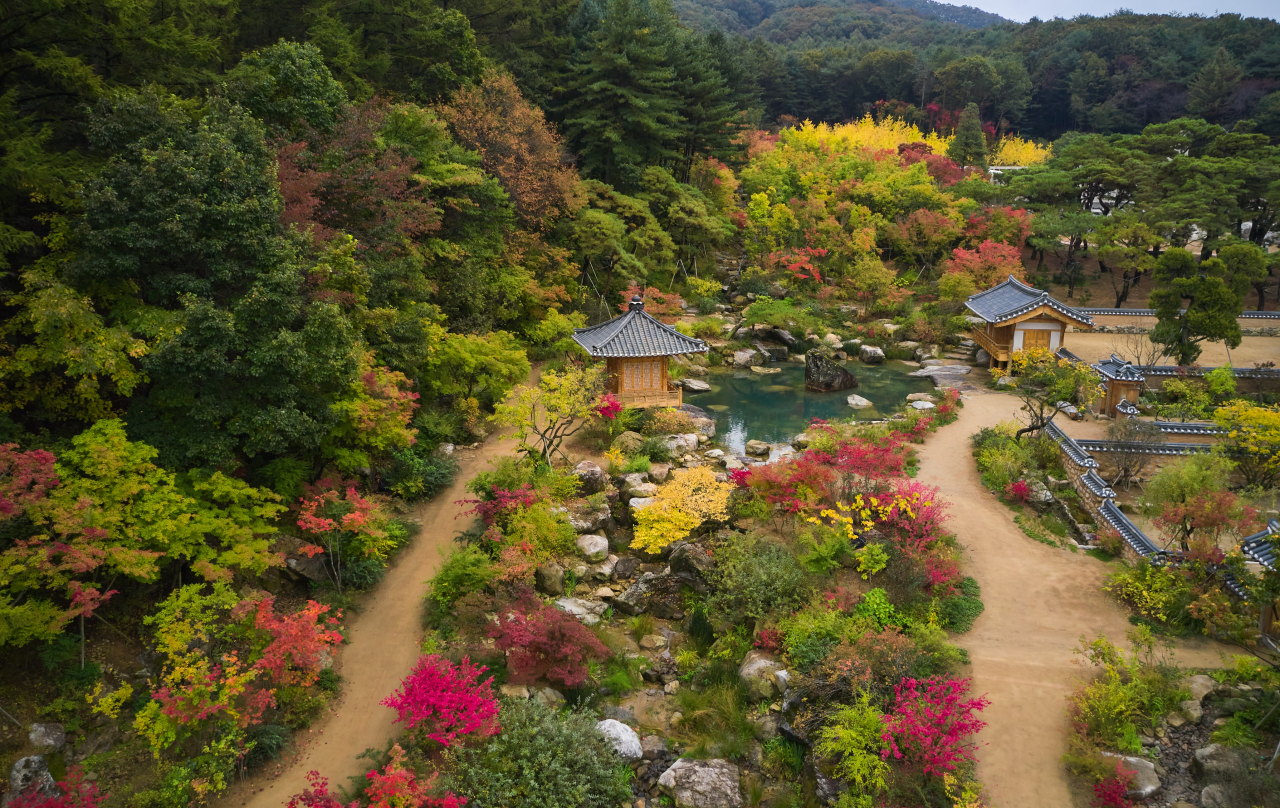 |
Jaeyedang at the Elegance of Seonbi garden at “Les Jardins de Medongaule” in Yangpyeong County, Gyeonggi Province. A large rock, named “Wonju Rock,” symbolizes “will to power” espoused by philosopher Friedrich Nietzsche. (Medongaule) |
YANGPYEONG, Gyeonggi Province -- Gardens are a place of serenity.
The Gardens of Medongaule -- formally “Les Jardins de Medongaule,” a garden complex scheduled for full opening next year -- are no exception.
Even more, the sheer size of the gardens will leave you awestruck.
The compound of Medongaule, meaning a valley (gaule) of bindweed (medon), spans some 200,000 square meters. That’s roughly the size of Ttukseom Hangang Park in Seoul.
Medongaule is divided into two main gardens: the Korean Gardens and the Contemporary Gardens.
Listening to the landscape architect and the head gardener elaborate on the philosophies communicated through the garden complex elicits respect for their work.
“It’s about living with nature and not going against it. That’s what the entire Korean Gardens represent. The opposite is true of the Contemporary Gardens, where using nature is key,” landscape architect Lee Jae-yeon said during a preopening tour on an October afternoon.
Korean Gardens
Three smaller gardens make up the Joseon-era (1392-1910) style Korean Gardens: the Lives of Commoners, the Elegance of Seonbi (scholars) and the Spirit of the Korean People.
The Lives of Commoners garden is for identifying with nature and the history of the land -- from flowers and trees to trails and streams.
“Setting up this zone, we thought about what commoners must have seen and felt at the time,” Lee said.
Lee added that the design wasn’t just about relishing in nature, referring to fields of rice and cotton and streams that share the zone. These were places where commoner’s daily routines like harvesting and laundering took place.
 |
Seongok Seowon Academy stands at the Spirit of the Korean People garden at “Les Jardins de Medongaule” in Yangpyeong County, Gyeonggi Province. (Medongaule) |
Meanwhile, “hanok,” or traditional Korean houses, and pavilions characterize the Elegance of Seonbi garden. Spaces between structures suggested how seonbi sought to live a humble life, valuing spiritual maturity over materialism.
Minimalism practiced in the process demonstrates a pursuit of life with nature, Lee said.
Guillaume Gosse de Gorre, a French landscape designer, said he learned what he called a “deeper philosophy” while working the zone with Lee.
“I had known Japan as a country of samurai warriors,” de Gorre said. “I now see Korea as a country of scholars.”
What stands out in the Spirit of the Korean People garden, the third and last one in the Korean Gardens, is Seongok Seowon Academy. “Seowon” were Neo-Confucianism academies that taught seonbi to not only live with nature and seek truth but also aspire to be a man of “ideal virtue.”
Pine trees around the academy represent seonbi’s integrity, while natural arrangements of structures and their surroundings, such as trees and rocks, reflect the staples of Korean gardens, Lee explained.
Contemporary Gardens
The Contemporary Gardens comprises Humanities Island and the Gardens of Modern Korean History.
Sabatino Urzo, the head gardener from Italy, said Humanities Island pays tribute to such towering figures as Buddha, German philosopher Friedrich Nietzsche, French author Antoine de Saint-Exupery of “The Little Prince,” Greek writer Nikos Kazantzakis and the Joseon-era scholar Ryu Seong-ryong.
Namesake gardens of each figure are spaced throughout the area.
Choi Jin-won, the general manager overseeing the garden business on behalf of the Medongaule owner and architect, said the Gardens of Modern Korean History needed to be apart from the Korean Gardens, a space dealing with “everything traditional.”
“Age of Hardship,” “Age of Overcoming” and “Age of Prosperity” are some of the gardens that make up the Gardens of Modern Korean History.
 |
The Elegance of Seonbi garden at “Les Jardins de Medongaule” in Yangpyeong County, Gyeonggi Province. (Medongaule) |
Choi did not go into detail about Medongaule’s owner, who he said wished to remain anonymous. “The architect does not want to steal the focus from the gardens themselves,” Choi noted, adding he and the owner are long-time friends.
According to Choi, the Medongaule project was first conceived in 2012, and the owner began buying land in 2016.
“Overall planning took a lot of time,” Choi said of the “meticulous preparation” by his friend to build a “one of a kind garden.”
“He had a conviction that if people could appreciate and celebrate together a storied garden of this scale, that’s a leap for the arts and for society.”







![[Today’s K-pop] Blackpink’s Jennie, Lisa invited to Coachella as solo acts](http://res.heraldm.com/phpwas/restmb_idxmake.php?idx=644&simg=/content/image/2024/11/21/20241121050099_0.jpg)